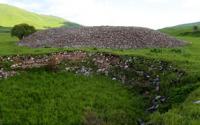You are here
Valikhanov about San-Tash barrow.

Travels to Issyk-Kul lake.
“All morning on the 25th, negotiations were going on between the Dulats and the Bugu. 10 Cossacks were sent to the auls of the aryk clan to collect carts. After dinner, the detachment withdrew and went northeast (correctly southwest) to Santash.
From the upper reaches of the Karkara, the terrain is flat, food is plentiful, and in general the vegetation here is the richest: tall grass, as the Kirghiz say, reaching in autumn to the rider's stirrups, various broad-leaved plants grew densely both in the meadows and along the slopes and mountain tops.
Particularly remarkable were the plants: mint (English) and a genus of reeds with leaves, as on jigara (sugar cane). The Kirghiz call this plant ak-kurgashen, while wild-stone people call it deer ear (deer fist)."
Chokan Valikhanov. "Diary of a trip to Issyk-Kul." 1856.
Best sights of Issyk-Kul lake.
“Santash is a counting stone. This passage got its name from a pile of stones laid in one barrow. Mound height in sazhens in 3, the circumference of sazhens is 35. The legend says that when Emir Temir-Kurgen (Emir Temir-Kurkan, as Tamerlane is called in the East) went to China to take the daughter of Emperor Kaan-Chin into his harem (kaanchin is the title of the emperor of China (in Turkic, otherwise) Khakanchin - the emperor of China, (title), turned by the Kirghiz into his own name), then ordered each of his warriors to put a stone in one place.
Upon his return, he ordered all the soldiers to take a stone and put it in another place. By the remaining unlifted stones, he judged his loss. The place of the former mound lies near and now. Historical reports completely contradict this legend. Tamerlane really went to China, but at the very departure from Samarkand he died in the ancient town of Otrar.
However, in all Central Asian legends, Tamerlane plays the first role, as in the Middle Ages in the knightly poems of Charlemagne and in Russian fairy tales, Vladimir the Red Sun. Turkestan attributes all mosques, all ancient water pipes to its conqueror, Emir Temir Sahib-Keran (winner of the world).
In any case, many people and a lot of labor were needed to build the Santash mound, and, of course, it is a monument that bequeaths to the coming days some significant fact in the life of some of the past (here) peoples.
P.S. The wild-stone Kirghiz attribute the Santasha mound to the Kirghiz Khan Ishim as a monument to his victory over the Kalmyk-Zungars. It's more likely. Ishim really was in these places and really won a victory over hontaiji.
Authority:
Chokan Valikhanov. "Diary of a trip to Issyk-Kul." 1856 Collected works in 5 volumes. 1985 Volume 1. Page 306 - 357.
Photos by
Alexander Petrov.







